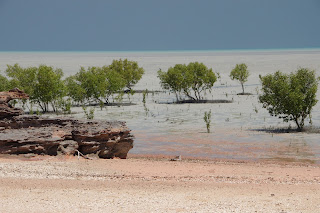 |
You can get a better look at these birds by clicking on the picture.
Unfortunately, my traveling electronics make it hard to do better.
This is a bowerbird. The male builds a bower to attract the female, often unsuccessfully.
At least she doesn't destroy the nest like female weaver birds in Africa. |
Broome is also one of the world’s most important stops for migrating shorebirds and other waterbirds. It is directly on the flyway between southern Australia and Antarctica on a line leading directly north over Indonesia, the Philippines, China, and Russia as birds make their way to their Arctic breeding grounds. Not all fly that far, but Broome is the perfect stopping point in Australia before they head overseas. As many as 800,000 birds either stop in Broome on their migration or actually reside on their wetlands.
 |
| Not identifying birds here. Too far away |
Because it is a small town so far from anywhere, it has avoided any development that has destroyed so much bird habitat elsewhere, leaving Broome with a variety of habitats for birds. Mangrove forest, wetlands, sandy shores, and mudflats are joined by dry forests and some open areas.

After breakfast we headed out to the Broome Bird Observatory. This observatory is world famous as a place to see, study, and learn about shore birds. Totally a non-profit, they offer onsite accommodations, daily tours and four week long courses on birding every year. One of the courses was just beginning as we arrived so there were no tours available, but the staff was still extremely helpful with suggestions of how to best see birds without a guide’s help. We also happened to arrive during a neap tide. Neap tides are medium tides, but there is not much difference between high and low tides. This means the shorebirds are not as visible as they are when the tides reach higher levels and the incoming tides push the birds closer and closer to the observation areas.
 |
| Australian Crow - Just as raucous as ours in America |
We began with a short walk to a tidal overlook where we saw several hundred shorebirds far enough out to be mostly unidentifiable. WE followed that with a walk along on the the trails. We saw a few birds, but by this time the heat of the day had quieted the activity quite a bit. We saw and heard a few birds and then headed to the Shadehouse where the course would be having lunch, but we could watch the birds at the water features until lunch began. Here we saw several new birds including some beautiful double barred finches and half a dozen others. The best part of being in the Shadehouse as they were preparing lunch is that one of the cooks helped us by answering questions and pointing out a couple of specialties. We also met a volunteer guide from the Auckland area who told us about Tiritiri Islandwe should visit because it has birds we would not be able to see on the New Zealand mainland.
 |
| Singing Honeyeater |
 |
| Peaceful Doves |
We then drove further out the coast to another recommended spot where we were able to walk down on the beach and get closer looks at the shorebirds and could identify several.
 |
| Better identification potential here |
 |
| And another beautifully sculpted beach |
The next morning I returned to the Observatory at sunrise to walk the trails and revisit the Shadehouse before we had to check out of our hotel. I enjoyed the early hours and managed to see several more new birds as I hiked both of their trails. Overall, I spent about five hours at the Observatory. The friendliness of their staff and the opportunity to see and learn about birds in this great habitat do make me want to return here again.
 |
| Red-backed Fairywren. Fairywrens point their tale to the sky making them easy to identify. |













No comments:
Post a Comment